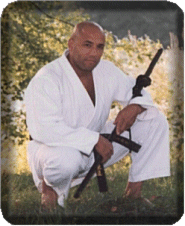
What is Aikido?
A method of unarmed self-defense. The key to Aikido is using
the attackers force against them. Aikido offers many advantages to its
practitioners: it develops rhythmic movement and physical fitness; it
encourages discipline and a nonviolent attitude; it promotes strength and
suppleness in the joints and limbs through twisting, bending and
stretching-movements that also free the limbs from harmful adhesions; it
increases awareness of good body alignment, and improves reactions,
perception and coordination.
Aikido's
History
The art of Aikido was founded by Morihei Ueshiba ("O
Sensei") born on December 14, 1883.
after many difficult and frustrating years on his quest for
the true meaning of martial arts, Morihei,at the age of 32, established
his own form of budo (Martial way) called Aiki-bujutsu. Master Ueshiba
studied under many of the great masters. A number of them whom Master
Ueshiba studied under died without ever revealing their arts to any other
disciple.
- Jiu Jutsu - Kito School under Master Tokusaburo Tojawa (1901)
- Fencing -Yagyu School under Master Masakatsu Nakai (1903)
- Jiu Jutsu - Daito School under Master Sakaku Takeda (1911-1916)
- Jiu Jutsu - Shinkage School (1922)
- Spear fighting - (1924)
Master Ueshiba taught many years in Japan, at one point even teaching
Japanese naval Officers his style of self-defense. He had gained much fame
throughout the country with his new effective martial art style.
The outbreak of the Pacific War in December 1941 and an increasing
shift towards militarism in Japanese society could not but hinder Aikido's
growth. As with the majority of young men, most of Master Ueshiba's male
students were drafted into the armed forces. The number of Aikido and
Martial arts students was greatly reduced. At one point, the government
tried to unify all of the Martial arts groups into one single body under
its total control.
Strongly opposed to being merged with other groups as just another
Martial art form, Master Ueshiba came to feel that another name for his
art would be more appropriate. In February of 1942 Aikido was officially
recognized as the name of the founders style. As Aikido gained much
acclaim, Master Ueshiba's students and friends began calling him "O "
Sensei which means first teacher. Many people who knew him recall him as
being one of the most honorable people they had ever met. In 1969 Master
Ueshiba passed away leaving Kishomaru, one of his three sons, to inherit
leadership of Aikido to its form today.
What is Saboten Ryu
Aikido?
Saboten translates from Japanese to mean Cactus and Ryu meaning Style,
alluding to the fact where a cactus can never attack, it only defends and
helps provide life. Saboten Ryu Aikido is a combination of traditional and
new Aikido techniques and grappling techniques formed together to
provide defense on the ground and in an upright position.
History of Saboten Ryu
Aikido
The founder of Saboten Ryu Aikido is Sensei Keith R. Badyna.  This style
of Aikido comes from Tomiki or free fighting Aikido. After many years of
studying Tomiki Aikido, Sensei Badyna decided to study many different
Martial arts. The arts he focused his time with with were: This style
of Aikido comes from Tomiki or free fighting Aikido. After many years of
studying Tomiki Aikido, Sensei Badyna decided to study many different
Martial arts. The arts he focused his time with with were:
- Hakaishi Judo for the strong grabs and throws
- Show-Gar Kung Fu with fast arm and foot movements
- Sekiguchi Ryu Jiu-Jitsu for fantastic ground fighting techniques
- Shukokai Karate with its powerful striking
Out of all of the arts, attitude, discipline, focus and mind set must
be central to martial artists. Therefor Sasori Ryu Ninjitsu became his
final choice, in which Sensei Badyna holds a 2nd Dan and was the last
student of the Great Master Surol Sha and Sensei Paul Shepard. Sensei
Badyna was given the title of Dai-Ni Shison which means "Second Son".
Weapons work must be included in this art Sensei Badyna said, so very
technical training started with Soke Toshishiro Obata in the sword art of
Kenjutsu. After attaining much knowledge about the other arts he returned
to Aikido with changes in mind.
With the violence and unsafe Martial arts practice in the world, and
all this information in his head, Sensei Badyna decided it was time for
some changes to be made in Aikido. Master Ueshiba had said "growth can not
take place without change". Change it did, through Sensei Badyna,
utilizing old tradition and new techniques. Pulling specific things from
what he had learned then making changes to them so they were more more
effective and realistic, He has created one of the most effective
self-defense arts in the world today.
With much praise from his instructors and many prestigious awards from
the global Aikido & Martial arts community, Sensei Badyna has pledged
to help make the world a better and safer place through proper Martial
arts instruction.
|